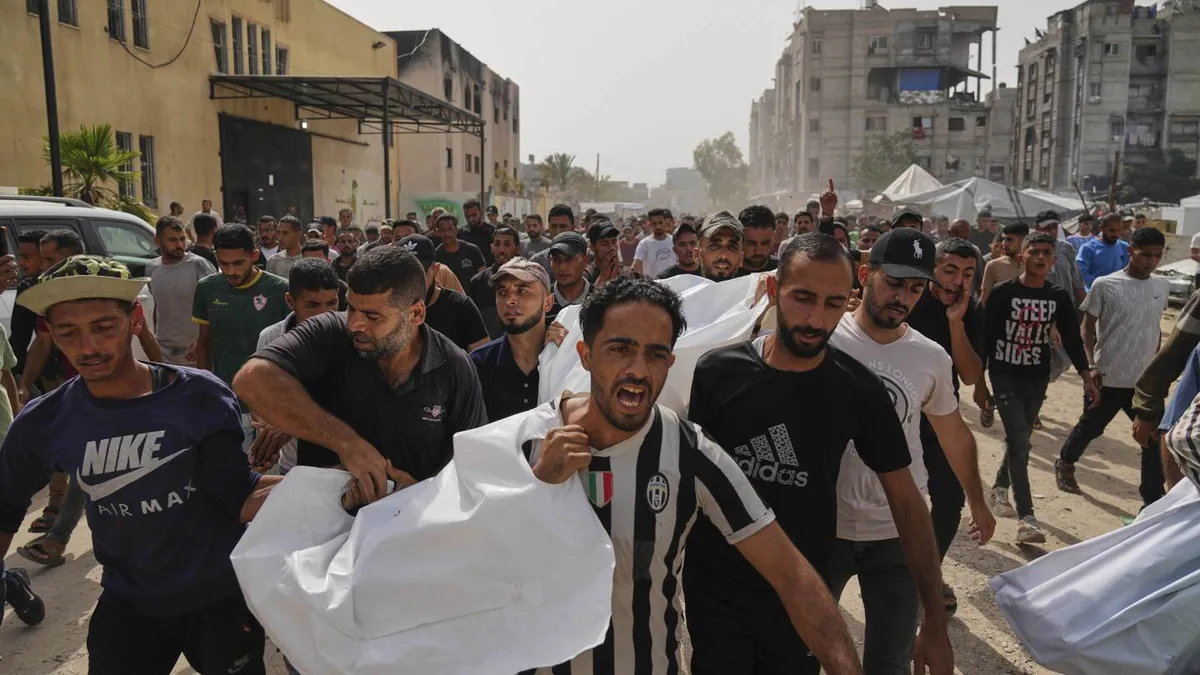
In a devastating escalation of violence, Israeli airstrikes across the Gaza Strip resulted in the deaths of at least 103 individuals overnight into Sunday. Hospitals and medical personnel within the beleaguered enclave reported these casualties, highlighting the ongoing brutality of a conflict that has shown no signs of resolution after more than 19 months.
Among the fatalities, over 48 people were killed in airstrikes targeting the southern city of Khan Younis. These strikes, which struck residential homes and tents that were providing shelter for displaced persons, were confirmed by Nasser Hospital. The toll included 18 children and 13 women, as reported by hospital spokesperson Weam Fares.
In northern Gaza, a tragic airstrike on a home within the densely populated Jabaliya refugee camp resulted in the deaths of nine family members. Another strike in the same area claimed the lives of 10 individuals, including seven children and one woman, according to information from the Gaza health ministry’s emergency services and the local civil defense.
The Israeli military has yet to comment on these lethal airstrikes. However, Israel often attributes civilian casualties to actions by Hamas, claiming that the militant group operates from within civilian neighborhoods. The ongoing bloodshed is part of a broader military campaign, with Israel launching a new offensive dubbed “Gideon’s Chariots.” This operation aims to seize territory, displace a significant number of Palestinians toward southern Gaza, and enhance control over humanitarian aid distribution.
Israel asserts that this new strategy is designed to exert pressure on Hamas to agree to a temporary ceasefire. This ceasefire would aim to secure the release of Israeli hostages held in Gaza but does not guarantee an end to hostilities. Conversely, Hamas demands a complete withdrawal of Israeli forces from Gaza and a comprehensive resolution to the ongoing conflict as prerequisites for any ceasefire.
Prior to the escalation, Israel had paused its military operations to allow diplomatic efforts for a new ceasefire deal during U.S. President Donald Trump’s visit to the region. Despite ongoing negotiations in Doha, Qatar, there has been no significant breakthrough. The previous ceasefire, which lasted for eight weeks, was shattered in mid-March, leading to a resurgence in violence that has resulted in hundreds of casualties.
In the wake of renewed military actions, Israel has also implemented a blockade, halting all imports into Gaza, including essential supplies such as food, medicine, and fuel. This blockade has exacerbated the humanitarian crisis in the region, raising alarms about the worsening conditions and the increasing risk of famine.
The current conflict in Gaza ignited on October 7, 2023, when Hamas militants launched an attack on southern Israel, resulting in the deaths of 1,200 individuals and the abduction of 251 others. In retaliation, Israel’s military operations have claimed the lives of more than 53,000 Palestinians, many of whom are women and children, according to Gaza’s Health Ministry.
As the war in Gaza continues, tensions have escalated with the Iranian-backed Houthi rebels in Yemen, who recently launched missiles targeting Israel. The Israeli military successfully intercepted a Houthi missile early Sunday, prompting air raid sirens across multiple regions. The Houthi military claimed to have fired two ballistic missiles toward Israel’s main airport near Tel Aviv, marking a significant escalation in hostilities.
Israel has conducted airstrikes in Yemen in response to Houthi attacks, further complicating the regional security landscape. As the situation develops, the humanitarian crisis in Gaza continues to deepen, underscoring the urgent need for a comprehensive resolution to the conflict.